Managing a single company vehicle is straightforward enough. But as your operations expand and your fleet grows, new challenges begin to emerge — planning optimal routes, maintaining your vehicles, meeting compliance requirements, etc.
Effectively managing your fleet is key to minimizing operational costs and maximizing driver productivity. But how do you address the challenges of an expanding fleet?
This is where fleet management software comes in.
The following looks at what fleet management software is, the core functions it offers, and how it benefits your company. We’ll also look at how you can implement fleet management software.
What is fleet management software?
Fleet management software is a technology that enables companies to track their vehicles and assets in real-time. It allows you to manage your fleet, optimize their efficiency, and reduce operation and maintenance costs — all from one application.
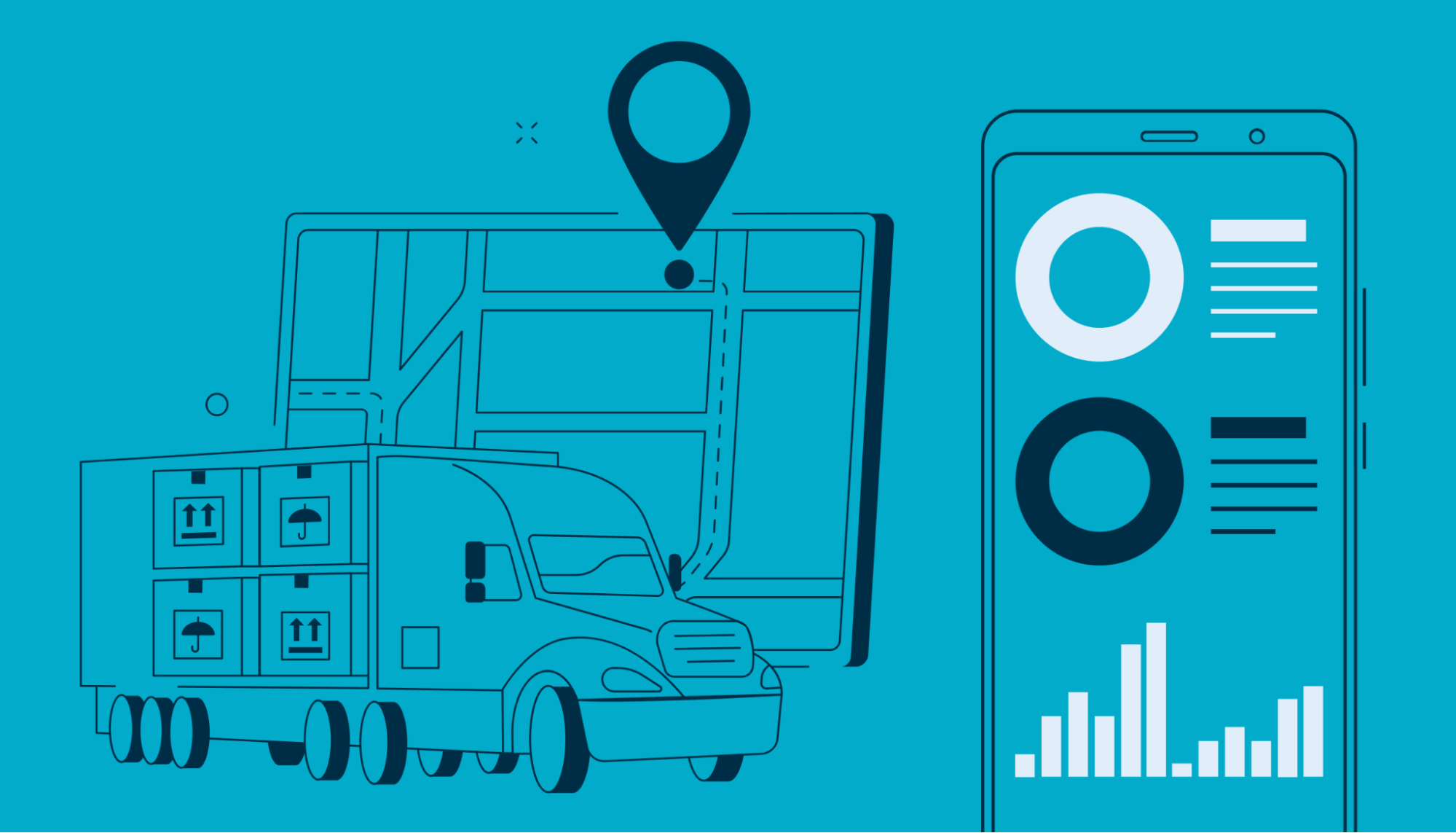
Fleet management software relies on telematics devices that collect, process, and transmit the data through a cloud server. These devices plug directly into a vehicle’s diagnostic ports, which provide a stream of information like:
- Vehicle location
- Vehicle speed
- Fuel consumption
- Time and distance traveled
- Engine idling time
- Driving behavior
This information is sent to a cloud server and accessible through fleet management software like CalAmp Fleet Telematics. Fleet managers can generate on-demand reports, view historical trends, and monitor their fleet right from the dashboard.
Common features of fleet management software
Whether you have a handful of trucks or hundreds of commercial vehicles in your fleet, good fleet management is a must. But trying to manage your fleet with spreadsheets or paper isn’t practical.
Here are some of the key features that vehicle fleet management software offers.
GPS tracking
Global Positioning System (GPS) tracking is one of the core features of fleet management software. These systems help you monitor your fleet and track your assets in real-time.
Coupled with telematics, you can also track things like vehicle speed, engine performance, fuel usage, and more. These insights can help you streamline your operations and monitor driver performance.
Route planning and optimization
Whether it’s delivering goods or meeting with customers, you want your drivers to take the most efficient routes. Otherwise, they’ll spend more time on the road and expend more fuel.
Another feature of fleet management software is the ability to plan and optimize routes in advance while taking fuel stops and breaks into consideration. Route optimization can save on fuel costs and improve delivery times.
Geofencing or region monitoring
Geofencing is the process of creating virtual boundaries. It allows you to monitor and restrict the movement of your fleet to specific regions.
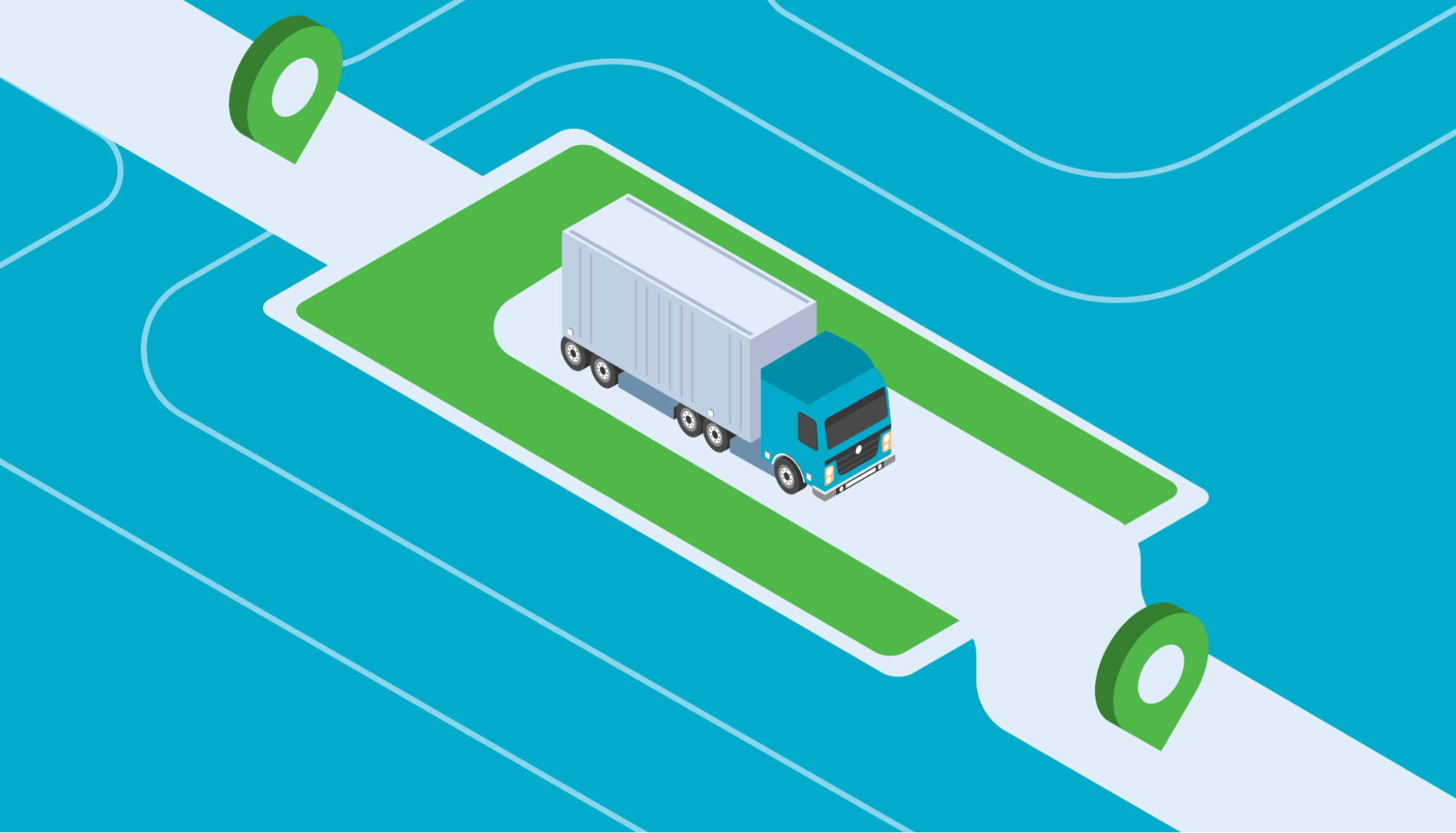
With geofencing, you can set up alerts when drivers enter or leave designated areas — useful as you can provide real-time updates to your customers. You can also receive notifications if drivers deviate from designated boundaries without authorization.
Maintenance scheduling
Fleet management software includes features that let you stay on top of regular servicing like oil changes, wheel alignments, and more. It can also remind you when certain services are due based on engine data like mileage.
Keeping your fleet in peak condition can help minimize downtime, extend the lifespan of your equipment, and improve driver safety.
Detailed reporting
Fleet management software provides a wealth of information that fleet managers can use to assist with route planning, improve fleet efficiency, and protect valuable assets.
These include:
- Distance driven
- Engine idle time
- Number of stops
- Average time on site
- Speeding events
With this information, fleet managers can take steps to maximize vehicle utilization and improve driver safety. For example, if they notice excessive engine idling time, they can reiterate the importance of shutting engines down.
Benefits of fleet management software
Managing a fleet can be challenging. That’s why more fleet managers rely on fleet management software to gain a more holistic view of their fleet.
Here are some of the top benefits of implementing fleet management software.
Improve driver safety and monitor performance
Driver safety is of utmost importance.
Fleet management software features telematics that are built into your vehicles, which relay data through onboard sensors in real-time. Fleet managers can monitor data like engine speed, idling time, location, and other key vehicle diagnostic data.
Aggressive driving behavior like excessive speeding and harsh braking can increase operational costs by damaging precious cargo, increasing the potential for an accident and elevating liability risk to the fleet operator. Fleet managers can set up real-time alerts for these types of behaviors.
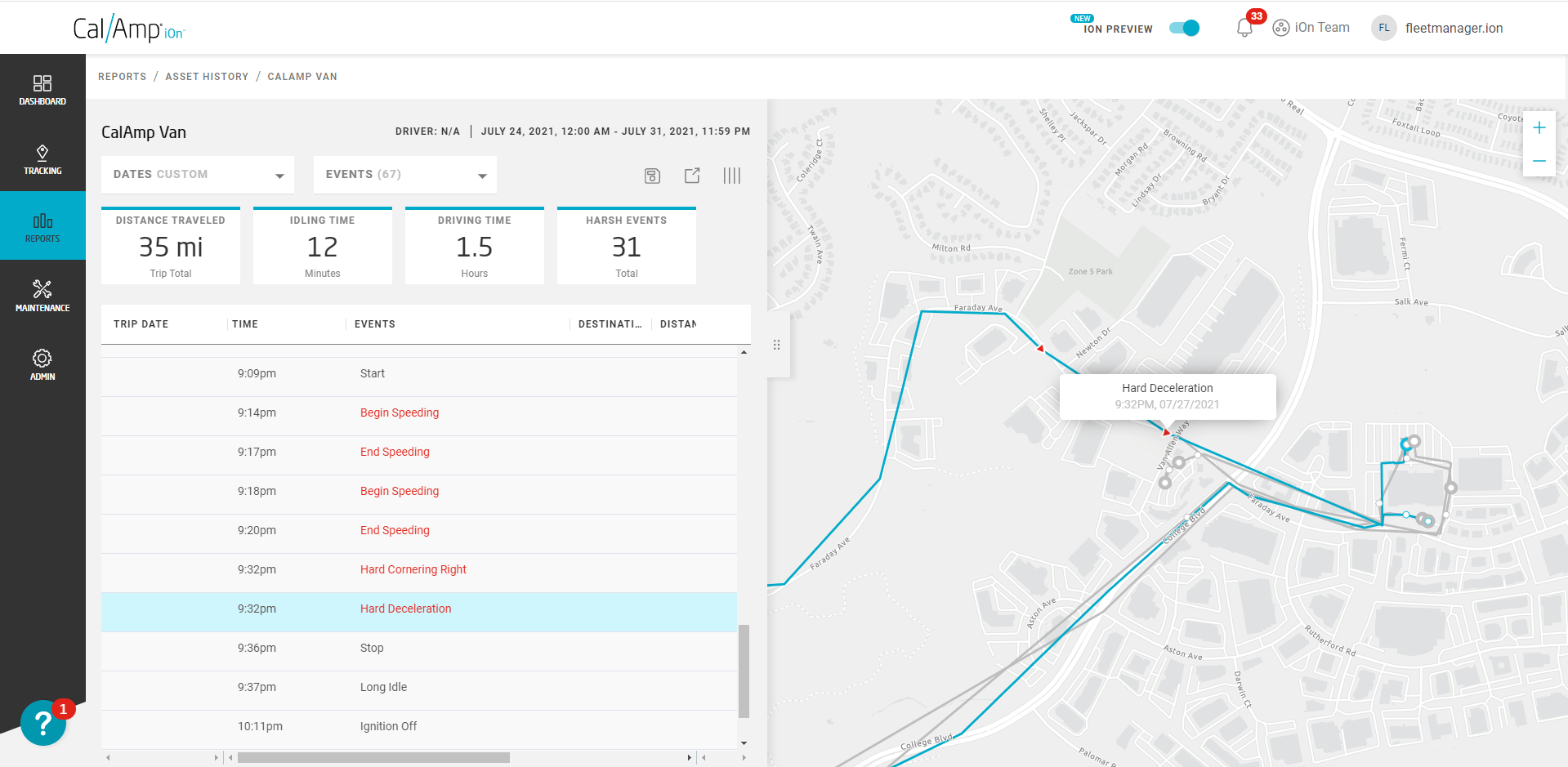
Additionally, fleet managers can access feeds through dashboard video cameras to review incidents. By monitoring driving behavior, you can take steps to improve driver safety. Examples include updating your training and creating programs to reward safe driving.
Schedule preventative maintenance and reduce unscheduled downtime
Vehicle downtime can cost anywhere from $488 to $760 to $760 per vehicle a day, and that doesn’t even include the cost of repairs. Performing preventative maintenance can keep unscheduled downtime to a minimum. Examples include performing regular oil changes, checking spark plugs, and replacing brake pads.
Of course, keeping track of routine maintenance for an expanding fleet isn’t easy. Fleet management software like CalAmp Fleet Telematics helps you identify minor issues before they turn into bigger problems.
With CalAmp Fleet Telematics, you can also create scheduled reminders based on mileage and usage. This helps you stay ahead of maintenance schedules, which keeps your fleet running efficiently and your drivers safe.
Lower fuel consumption
The Department of Energy estimates that heavy-duty trucks consume about 0.8 gallons of fuel per hour when their engines are idling. The American Trucking Association estimates that idling doubles engine wear and tear due to a buildup of carbon residue, costing an additional $2,000 per truck annually for maintenance.
Fleet management software can help lower fuel consumption. One way it does this is by monitoring engine idling time. Fleet managers can take this data and help establish best practices for reducing unnecessary engine idling.
Maintain ELD compliance
As of December 2017, most commercial vehicles (CMV) must have an electronic logging device (ELD) installed according to the United States Federal Motor Carrier Safety Administration (FMCSA).
The mandate is intended to improve driver safety and keep fatigued drivers off the road. Vehicle operators must record their Hours of Service (HOS) electronically. The HOS rule states that truck drivers may only drive a maximum of 11 hours in a 14-hour shift.
CalAmp has partnered with assured Telematics to deliver a comprehensive ELD solution that helps you maintain compliance. assured Telematics’ apollo ELD has been approved by the FMCSA and lets drivers easily manage their HOS logbooks, report vehicle inspections, and more.
Prevent instances of fraud
A reality that fleet managers have to contend with is fraud. Some examples include drivers using fuel cards for personal expenses or even using company materials for side businesses.
Fleet management software combined with a tracking solution like CalAmp Tags lets you keep tabs on valuable assets.
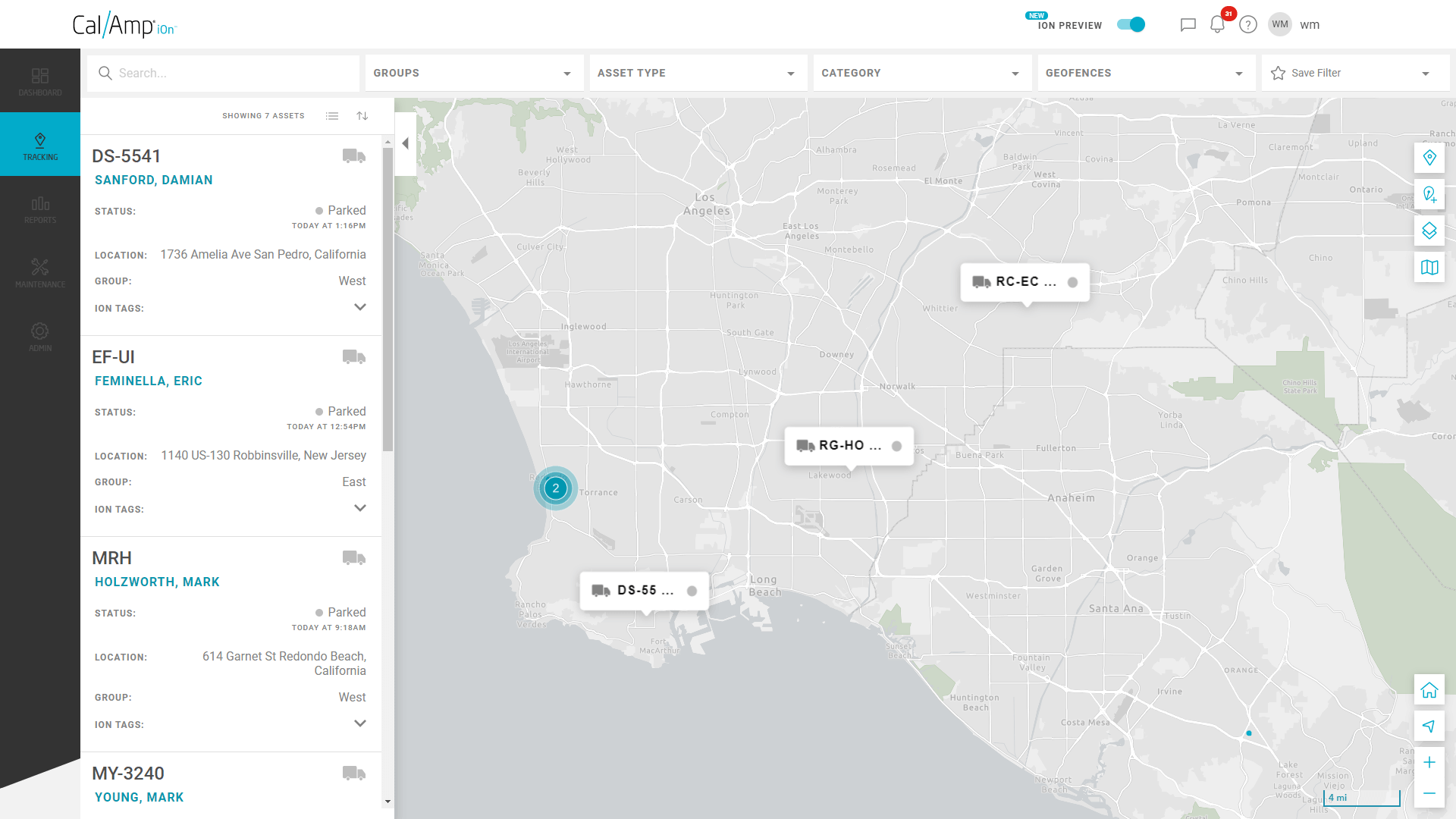
In one case, a heating and air conditioning company suspected that employees were using company-purchased Freon for non-business activities, costing the company hundreds of dollars each week.
With a CalAmp Tag affixed to Freon canisters and set to perform regular scans, the owner was able to confirm his suspicions. Read how the HVAC company used CalAmp Tags to track company assets and prevent fraud.
With these key benefits in mind, it’s clear that fleet management software can positively impact your business.
Who uses fleet management software?
Nearly every company that operates commercial vehicles relies on fleet management to some degree. Here’s how employees across different sectors use fleet management software to keep things running smoothly.
Fleet managers
Fleet managers oversee fleet operations. Their tasks include scheduling vehicle maintenance, monitoring driver behavior, and determining how many and what type of vehicles are needed to operate efficiently.
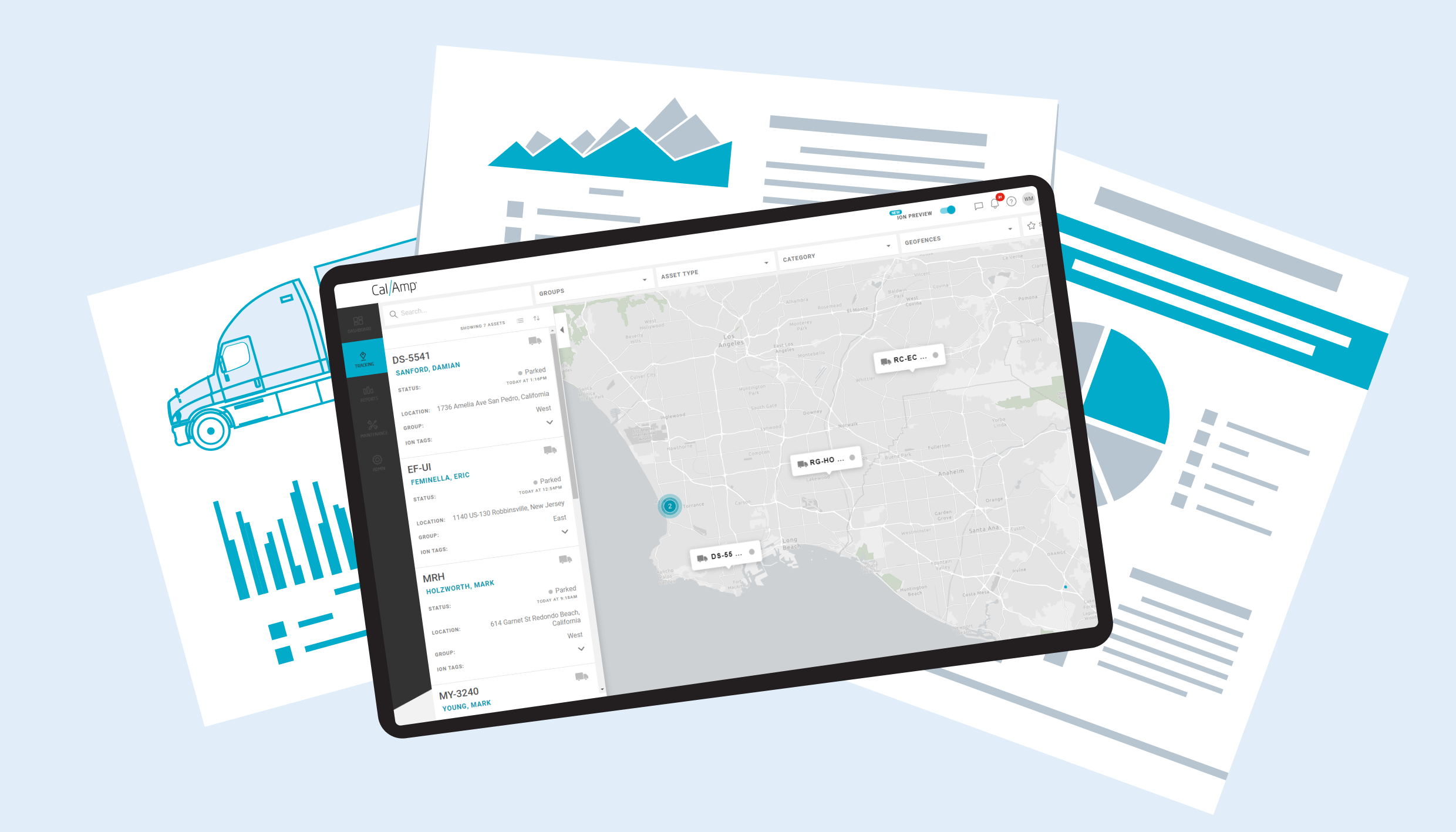
Fleet management software helps fleet managers gain a real-time view into their entire fleet, so they can make smarter and better business decisions.
Project managers
Project managers are responsible for getting projects delivered on time and within budget. Part of their responsibilities include planning and organizing all the necessary resources.
For example, project managers on a construction site can use fleet management software to ensure that the equipment and tools are at the right place at the right time.
Maintenance managers
Fleet maintenance managers are responsible for coordinating maintenance and repairs. Their job is to minimize unscheduled downtime and keep vehicles in optimal condition.
With fleet management software, maintenance managers can monitor each vehicle's overall “health” and get alerts when certain engine codes are triggered.
Logistics managers
Logistics managers coordinate the storage and distribution of goods. They can use fleet management software to get real-time visibility of cargo and keep company supply chains running efficiently.
Safety managers
Safety managers play a vital role in fleet management. With fleet management software, they can monitor driver behavior, review vehicle accidents, and establish new policies to prevent similar occurrences.
Compliance managers
Any company operating a fleet must comply with Department of Transportation (DOT) and FMCSA regulations. Failure to comply can result in heavy penalties or being put out of service.
Compliance managers can use fleet management software to ensure drivers log their HOS and verify that vehicles have completed the necessary inspections.
Drivers
Of course, drivers can use fleet management software via an interface to access customer information, track their daily schedules, collect signatures, and more.
These are just some of the many ways that employees in your organization can use fleet management software. Other examples include senior executives tracking key performance indicators to identify areas of improvement.
A step-by-step guide to implementing fleet management software
A more efficient fleet ultimately has a more positive impact on your bottom line. But you need the right tools to manage and streamline your operations.
Follow these steps to implement fleet management software in your organization.
1. Get buy-in from leadership
Implementing fleet management software is a massive undertaking, which is why it’s important that you get buy-in from key stakeholders.

The first step to getting buy-in is considering the implementation's impact (e.g., fleet managers, technicians, drivers, etc.). Then show how fleet tracking software will benefit each group.
For example, if unscheduled downtime is causing headaches for fleet managers, you can show how the use of software can help them stay on top of maintenance schedules. Provide data and metrics to gain support for your vision.
Be sure to also get feedback from key stakeholders. Your team will be more receptive to change if they feel they have a part in the implementation.
2. Define your fleet management needs
Before you start looking for fleet management software, you need to determine what your needs are. A good place to start is to write down any problems or challenges your team faces.
Common challenges that fleet managers face include:
- Keeping vehicles in optimal condition
- Controlling fuel and maintenance costs
- Managing delivery schedules
- Avoiding information overload
- Meeting compliance requirements
Defining your fleet management needs will help you find the right solution. It’ll also help you determine the most important features for your organization.
3. Set your fleet management goals
The next step is to set goals for fleet management software implementation. This will enable you to establish baselines and measure progress.
Some examples of goals that you can set include:
- Improve delivery times by x%
- Reduce the number of road incidents by x%
- Reduce fuel and operating costs by x%
- Reduce average time on site by x%
Comparing these metrics before and after will enable you to measure the impact of your chosen fleet management platform.
4. Choose fleet management software
Choosing the right fleet management software isn’t easy as there’s no shortage of options available. Here are some things to consider to help you narrow down your choices:
- Features: Consider your fleet management needs to determine what features are important for you. For example, if fuel management is one of your top priorities, you’ll want to look for software that highlights engine idle time and monitors fuel usage.
- Ease of use: The goal of using fleet management software is to streamline your operations. The solution you choose should have an intuitive interface that your entire team can start using right away with minimal training.
- Scalability: You might only have a few vehicles in your fleet, but that number can grow quickly as your operations expand. The best vehicle fleet management software will be able to scale with your needs effortlessly.
- Installation: Telematics devices enable you to track your vehicles using GPS. However, one important consideration is how easy (or difficult) it is to install these devices.
- Customer support: Technical issues can cause unnecessary delays to your operations. Make sure you go with a provider that offers excellent customer service. If you need help, you know that you’ll be able to get it.
Compile a list of different providers and compare each option against your list of needs. If a fleet management solution doesn’t have a feature you need, cross it off your list. Consider putting together a software selection team to help with this step.
5. Create an implementation plan
Rolling out significant changes all at once is generally not a good idea. Instead, you’ll want to create an implementation plan that breaks down the process into smaller steps. This will help your team gradually adjust to the new changes.
Nominate a project lead to oversee the rollout of your implementation plan. This person will work with individuals that oversee different aspects of your fleet operations — maintenance, compliance, etc. For example, they will coordinate with fleet managers to ensure that vehicles are ready for installations.
As you implement your plan, make sure that you communicate with your team. Organizational changes are 6.3 times more likely to succeed when leaders are transparent about change efforts with the rest of the organization.
6. Educate and train your team
Whether you’re getting started with fleet management software for the first time or you’re changing solutions, make sure to provide adequate training. The last thing you want is for your drivers to be in the field and not understand how certain features work.
Hold on-site training sessions to help your drivers familiarize themselves with the fleet management software you choose and encourage questions. Anyone who will use the platform, such as fleet managers and technicians should also receive training.
Finally, remember that training is an ongoing process. If you make any changes to your company fleet policy, have your team go through the relevant sections again.
Conclusion
There’s no doubt that technology can make your operations more efficient. With fleet management software, you can improve driver efficiency, reduce unscheduled downtime, and extend the lifespan of your equipment.
CalAmp Fleet Telematics fleet management software comes with everything you need to manage your fleet — track your vehicles and assets in real-time, generate custom reports, schedule maintenance work, and more.
Request a demo today to see our fleet management software in action, or contact our team if you’re looking for something more specific.
